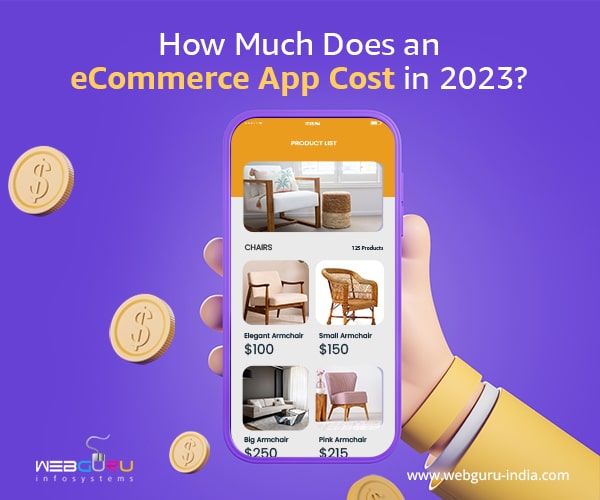Home Blog Mobile App Development How Much Does an eCommerce App Cost in 2023?
How Much Does an eCommerce App Cost in 2023?
- 24 Feb / 2023
- 1,971 views
- 7 Min Read

Ecommerce has grown to be a crucial component of the retail sector in the digital era. More and more customers are using eCommerce apps to buy their favourite items as the use of smartphones and the internet increases. eCommerce applications are becoming more and more in demand, and their creation is becoming more and more expensive. In this blog article, we’ll look at the variables influencing the price of developing an eCommerce app in 2023 and how companies may maximise their investment.
Factors that Affect eCommerce App Development Cost
Read on to find out the top factors that will influence the cost of your app:
1. Design and User Interface
The design and user interface of an eCommerce app are crucial factors that play a vital role in its success in the market. Although a poorly designed software might rapidly lose users, one with a meticulously-designed and user-friendly UI can draw them in and keep them engaged. To guarantee that the app satisfies the demands and preferences of its users, it is crucial to invest in a high-quality design and user-friendly interface.
The cost of design and user interface for an eCommerce app can vary depending on the complexity of the design and the experience of the designer. A simple and minimalist design may be less expensive than a complex and intricate design that requires more time and effort to create. Similarly, a designer with more experience and expertise can perhaps create a better UI and may charge more for their services than a less experienced designer.
Businesses should collaborate with seasoned designers who are aware of the demands and preferences of their target audience if they want to guarantee a high-quality design and user interface. Furthermore, it’s the designer’s responsibility to create a layout that is aesthetically satisfying and easy to use. At the same time, has features that can be easy to understand and should enhance user experience.
2. Features and Functionality
The features and functionality of an eCommerce app are key considerations for businesses when developing an app. It’s the functionality along with the features that influences the functionality of the app. Also, determines if it offers a user-friendly experience and satisfies the needs of the target audience.
It’s crucial to find a balance between offering a rich user experience and keeping the cost of development within a manageable budget when choosing features and functionality for an eCommerce app. The cost of developing an app may rise dramatically when adding additional features, and an app’s complexity might rise as well. It is crucial to concentrate on the fundamental features and functionality that will deliver the optimal user experience.
In-app messaging, social network integration, and third-party integrations like chatbots, various payment processors, and delivery providers are some of the top features that can raise the price of an eCommerce app. Push notifications, chatbots, and in-app messaging can provide valuable communication channels for businesses to engage with their customers, but they require additional development and maintenance to ensure they function correctly. Also, companies wanting to get the attention of their target audience and promote their products or services on social media platforms should consider social media integration to meet their goals. However, it can add to the cost of development. However, it can add to the cost of development.
3. Development Platform
When designing an eCommerce software, the choice of development platform is critical since it may dramatically effect development costs. There are several development platforms to choose from, be it for native or hybrid apps.
When deciding on a development platform for an eCommerce app, businesses should consider their specific needs and the needs of their customers. A native app may be the best solution if the programme requires extensive functionality or needs to take use of certain hardware or software characteristics. If the app needs to be developed at a competitive cost and deployed on multiple platforms, a hybrid app may be a good compromise.
The use of ready-made open-source e-commerce solutions like Magento, OpenCart, and WooCommerce as the back-end platform of the mobile app plays a significant role in development costs. It can make development costs much lower than a custom-developed backend. Also, which ready-made platform you choose for your backend also makes a difference in the cost of development.
In addition to the initial development costs, the choice of development platform can also impact ongoing maintenance and support costs. Native apps may require more overhead costs, as they need to be updated for each platform separately. Hybrid apps may require lower maintenance costs, as they can be deployed on multiple platforms with a single codebase.
Sounds too technical? Don’t worry. You can always consult with some of the leading mobile app development companies around you for a much clearer understanding.
4. Third-Party Integrations
It is very important to consider third-party integrations when creating an eCommerce app. Payment gateways, shipping providers, and other third-party services (like SMS) can add significant value to an app by providing convenient and secure payment and delivery options for customers, as well as notifications on their order status. However, these integrations also come with a cost.
The budget of integrating third-party services can vary depending on the level of complexity involved. Also, these services (such as customer support chat) may require custom development to integrate with an eCommerce app, which can be expensive. Also, the adding integrations makes an app more complex, which can lead to higher development, ongoing maintenance, and support costs.
5. Security and Compliance
Security and compliance are critical factors to consider when developing an eCommerce app. Customers expect their personal and payment information to be kept secure, and businesses have a responsibility to protect their customers’ data. Failure to do so may have negative effects on one’s reputation as well as legal and financial repercussions. Therefore, it is crucial to guarantee that the software is safe and in compliance with applicable laws.
Depending on the desired level of security and compliance, the cost of making sure an eCommerce software is secure and compliant might change. For all eCommerce apps, basic security precautions like SSL/TLS encryption, safe password rules, and two-factor authentication are necessary and reasonably affordable to install.
The price of creation and ongoing maintenance, however, might rise dramatically if an eCommerce software needs more sophisticated security features, such end-to-end encryption or biometric verification.The type of data being handled and the degree of risk involved with the app will determine the level of security needed.
Regulations such as the General Data Protection Regulation (GDPR) and the Payment Card Industry Data Security Standard (PCI DSS) require businesses to take specific measures to protect their customers’ data. Companies that will fail to abide by these guidelines may face significant fines and other legal consequences.
The cost of ensuring compliance with these regulations can also vary depending on the level of compliance required. For example, achieving PCI DSS compliance can be a complex and time-consuming process, requiring businesses to implement a range of security measures and undergo regular audits. And yet, it must be done if the business owner wants to save the card or other financial data of their customers within their eCommerce platform itself. The cost of non-compliance can be much greater, making it essential for businesses to invest in achieving and maintaining compliance.
For more insights, you may read this blog on Best Security Practices for E-Commerce App.
6. Maintenance and Support
Maintenance and support are ongoing costs that should be considered when developing an eCommerce app. Even after an app is launched, it will require regular updates and maintenance to ensure it remains functional, secure, and compatible with future iOS/Android updates. Failure to maintain an app can result in glitches, downtime, and security vulnerabilities, which can lead to negative customer experiences and reputational damage.
The cost of maintenance and support will depend on the complexity of the app and the level of support required. Simple eCommerce apps may only require basic maintenance, such as updating the app’s content or fixing minor bugs, which can be relatively inexpensive. However, more complex eCommerce apps may require ongoing maintenance and support from a dedicated team of developers and support staff, which can be more costly.
When planning for maintenance and support, businesses should consider factors such as the complexity of the app’s features, the size of the user base, and the frequency of updates. They should also consider the level of support required, such as the availability of customer support staff, and the cost of any third-party services that may be required for maintenance and support.
Cost Breakdown of eCommerce App Development
The average cost of developing a simple eCommerce app can range from $2,500 to $20,000. The cost of developing a more complex eCommerce app (like a full-fledged marketplace) can be significantly higher, going up to $250,000 or more.
Additionally, the kind of, as well as the number of third-party integrations can increase the cost. The cost of these integrations can start from $150 or so, but go up to $10,000 per integration or more.
Maintenance and Support Cost: The cost of maintenance and support can range from $2,000 to $20,000 or more per year.
Tips to Get the Best Value for Money
Take note of these points in order to avoid any unnecessary expenses:
1. Hire a Professional Development Team: Seeking the help of an experienced development team can ensure that the app is developed to the highest standards, which can reduce the cost of maintenance and support.
2. Choose the Right Development Platform: Choosing the right development platform can reduce the overall cost of developing an eCommerce app. A hybrid or web app can be less expensive than a native app, but it’ll also have some limitations in terms of UI/UX and functionality compared to native apps.
3. Prioritize the Features: Prioritizing the features of an app can help reduce its development cost. Businesses should focus on the most important features first and add additional features later.
4. Avoid Over-Engineering: Over-engineering an app can increase its development cost. Businesses should focus on developing an app that meets their specific needs without adding unnecessary features.
5. Optimize for User Experience: Optimizing an app for user experience can increase user engagement and reduce the cost of maintenance and support.
6. Plan for Scalability: Planning for scalability can ensure that an app can grow with the business, which can reduce the cost of redesigning and redeveloping the app in the future.
Conclusion
eCommerce app development is becoming increasingly important for businesses that want to stay competitive in the digital age. The future of eCommerce app development in 2023 is exciting, with more businesses investing in the development of mobile apps to meet the changing needs of consumers. With the right approach, businesses can develop an eCommerce app that is cost-effective and meets the needs of their customers.
9 comments
Leave a Reply

-
1000+
Happy
Clients -
25+
Countries
Served -
19+
Years of
Trust









Nice Blog sir
I found this interesting and useful.
Very Helpful post.
This blog post is an informative and well-structured guide for businesses looking to develop an eCommerce app in 2023. The author has done an excellent job of explaining the factors that affect the cost of eCommerce app development, including design and user interface, features and functionality, development platform, third-party integrations, and security and compliance. The post provides practical insights into how businesses can balance the need for a rich user experience with cost considerations, and highlights the importance of working with experienced designers and developers to ensure the best results. Overall, a great resource for anyone looking to develop an eCommerce app in the current digital age.
Your post has helped me better understand the complexities of developing an eCommerce app and the importance of investing in a high-quality design and user-friendly interface, as well as balancing the features and functionality of the app with the cost of development.
Once again, thank you for sharing your expertise and insights with us. Your post has been very helpful, and I look forward to reading more of your work in the future
Thank you for sharing such a wonderful post.
There is visibly a lot to know about this. I suppose you made various good points in features also.
This blog really helps me a lot. Informative article.
Keep up the great work! Thank you so much for sharing a great posts.
Great breakdown of eCommerce app development costs! This article does a great job of explaining the various factors that influence pricing, from app complexity and features to design, platform choice, and third-party integrations.
It’s especially helpful for startups and businesses planning their budget, as it highlights the cost differences between basic, mid-range, and advanced eCommerce apps. One aspect that could be explored further is the ongoing maintenance and scaling costs, which are crucial for long-term success.
Overall, a very informative read! Looking forward to more insights on cost-effective development strategies and tips for optimizing app performance.